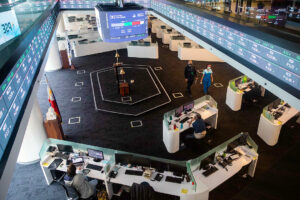PSEi may end above 7,000 this year on monetary policy easing prospects
THE BELLWETHER Philippine Stock Exchange index (PSEi) could end the year above the 7,000 mark on expectations of monetary easing here and abroad, analysts said, especially with the US Federal Reserve expected to kick off its long-awaited rate cut cycle this week. On Monday, the PSEi rose by 1.15% or 81.35 points to close at […]

THE BELLWETHER Philippine Stock Exchange index (PSEi) could end the year above the 7,000 mark on expectations of monetary easing here and abroad, analysts said, especially with the US Federal Reserve expected to kick off its long-awaited rate cut cycle this week.
On Monday, the PSEi rose by 1.15% or 81.35 points to close at 7,104.20, while the broader all-share index climbed by 0.82% or 31.37 points to 3,820.
Monday’s close was an over two-year high for the benchmark index, as it was its best finish since 7,142.42 on April 20, 2022.
This also marked a 10.14% or 654.16-point increase from the PSEi’s end-2023 close of 6,450.04.
The market’s rise was driven by anticipation for the Fed’s two-day policy meeting this week, where it is expected to cut rates for the first time in over four years.
Monetary easing prospects will likely continue to propel Philippine stocks in the coming months, analysts said.
“We’re still maintaining our projection at 7,355, but we’ll be open to revise after the Fed meeting,” AP Securities, Inc. Research Head Alfred Benjamin R. Garcia told BusinessWorld via Viber message.
China Bank Capital Corp. Managing Director Juan Paolo E. Colet said the PSEi might outperform expectations as market sentiment continues to improve.
“We are maintaining our 7,100 initial target for now. The current bullishness of the market and sustained net foreign buying make it increasingly likely that the index will reach and perhaps exceed that level,” he said in a Viber message.
“We will reassess the target as the market evolves in reaction to forthcoming economic data and the path of monetary policy easing,” he added.
Rizal Commercial Banking Corp. Chief Economist Michael L. Ricafort said he expects the PSEi to end at the 7,000-7,500 level this year.
“This is amid Fed rate and local policy rate cuts that could reduce the borrowing costs of listed companies,” he said in a Viber message.
“Rate cuts would also lead to faster economic growth in terms of more demand for loans, higher investments, more global trade such as exports and imports, more jobs, higher consumer spending, and more business and other economic activities,” he said. “These will in turn lead to higher sales and earnings of listed companies, which would lead to higher valuations and share prices.”
The US central bank has kept the federal fund target rate at 5.25%-5.5% range following increases worth 525 basis points (bps) from March 2022 to July 2023 to quell elevated inflation. It last cut rates in March 2020, bringing rates to near-zero to support the US economy during the coronavirus pandemic.
Fed speakers and data releases over the past month have had markets shifting the odds around the size of this week’s rate cut, debating whether the Fed will head off weakness in the labor market with aggressive cuts or take a slower wait-and-see approach, Reuters reported.
Futures markets were fully pricing a quarter-point cut from the Fed on Wednesday, with around a 60% chance they opt for a larger 50-bp move. Last week, the chances of a larger move stood at about 15%.
Markets widely expect the Fed to cut rates by at least 100 bps this year, with more reductions seen in 2025.
The Bangko Sentral ng Pilipinas (BSP) on Aug. 15 reduced its policy rate by 25 bps to 6.25%, its first easing move in nearly four years.
Prior to the cut, the Monetary Board kept the target reverse repurchase rate at an over 17-year high of 6.5% for six straight meetings following cumulative hikes worth 450 bps between May 2022 and October 2023 to help rein in rising prices.
BSP Governor Eli M. Remolona, Jr. has telegraphed another 25-bp cut within the year, but analysts have said that easing domestic inflation and expectations of several Fed easing moves this year may give the Philippine central bank confidence to slash borrowing costs further. The Monetary Board’s last two policy-setting meetings this year are on Oct. 17 and Dec. 19. — R.M.D. Ochave with Reuters












